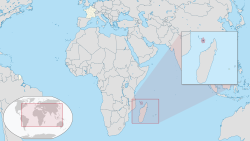Mayotte | |
|---|---|
Overseas department, region and single territorial collectivity of France and outermost region of the European Union | |
| Department of Mayotte Département de Mayotte (French) | |
| Anthem: La Marseillaise ("The Marseillaise") | |
 | |
 Mayotte in the Comoros | |
| Coordinates: 12°50′35″S 45°8′18″E / 12.84306°S 45.13833°E | |
| Country | |
| Prefecture | Mamoudzou |
| Departments | 1 |
| Government | |
| • President of the Departmental Council | Ben Issa Ousseni (LR) |
| Area | |
• Total | 374 km2 (144 sq mi) |
| • Rank | 18th region |
| Population (Jan. 2024)[1] | |
• Total | 320,901 |
| • Density | 860/km2 (2,200/sq mi) |
| Demonyms |
|
| GDP | |
| • Total | €2.932 billion |
| • Per capita | €11,300 |
| Time zone | UTC+03:00 (EAT) |
| ISO 3166 code | |
| Currency | Euro (€) (EUR) |
| Website | Prefecture Departmental Council |
Mayotte (/maɪˈɒt/ my-OT; French: Mayotte, [majɔt] ; Shimaore: Maore, IPA: [maˈore]; Kibushi: Maori, IPA: [maˈori]), officially the Department of Mayotte (French: Département de Mayotte),[3] is an overseas department and region and single territorial collectivity of France. It is located in the northern part of the Mozambique Channel in the Indian Ocean off the coast of Southeastern Africa, between Northwestern Madagascar and Northeastern Mozambique. Mayotte consists of a main island, Grande-Terre (or Maore), a smaller island, Petite-Terre (or Pamanzi), as well as several islets around these two. Mayotte is the most prosperous territory in the Mozambique Channel,[citation needed] making it a major destination for immigration.
Mayotte's land area is 374 square kilometres (144 sq mi) and, with its 320,901 people according to January 2024 official estimates,[1] is very densely populated at 858 inhabitants per km2 (2,228 per sq mi). The biggest city and prefecture is Mamoudzou on Grande-Terre. The Dzaoudzi–Pamandzi International Airport is located on the neighbouring island of Petite-Terre. The territory is also known as Maore, the native name of its main island.
Mayotte is one of the overseas departments of France as well as one of the 18 regions of France, with the same status as the departments of Metropolitan France. It is an outermost region of the European Union and, as an overseas department of France, part of the eurozone.
French is the official language and is spoken as a second language by an increasing part of the population, with 63% of the population 14 years and older reporting in the 2007 census that they could speak it.[4] The native languages of Mayotte are Shimaore, which is the most spoken, and the lesser spoken Kibushi, a Malagasy language, of which there are two varieties, Kibushi sakalava, most closely related to the Sakalava dialect of Malagasy, and Kibushi antalaotsi, most closely related to the dialect spoken by the Antalaotra of Madagascar. Both have been influenced by Shimaore.
The island was populated from neighbouring East Africa with later arrival of Arabs, who brought Islam. A sultanate was established in 1500. The vast majority of the population today is Muslim. In the 19th century, Mayotte was conquered by Andriantsoly, former king of Iboina on Madagascar.
Mayotte chose to remain with France[5] after the Comoros declared its independence following the 1974 referendum.[5] Mayotte became an overseas department on 31 March 2011 and became an outermost region of the European Union on 1 January 2014, following a March 2009 referendum with an overwhelming result in favour of the department status.
The department faces enormous challenges. According to an INSEE report published in 2018, 84% of the population live under the poverty line (established at €959 per month and per household), compared to 16% in metropolitan France, 40% of dwellings are corrugated sheet metal shacks, 29% of households have no running water, and 34% of the inhabitants between the age of 15 and 64 do not have a job.[6] In 2019, with an annual population growth of 3.8%, half the population was less than 17 years old. In addition, as a result of immigration from neighboring islands, 48% of the population were foreign nationals.[7]
- ^ a b "Estimation de population par région, sexe et grande classe d'âge – Années 1975 à 2024" (in French). Retrieved 17 January 2024.
- ^ "EU regions by GDP, Eurostat". Retrieved 18 September 2023.
- ^ Mayotte devient le 101e département français le 31 mars 2011 (PDF) (in French), Ministère de l'intérieur, de l'Outre-Mer, des collectivités territoriales et de l'immigration, p. 4, archived from the original (PDF) on 4 March 2016, retrieved 30 July 2015
- ^ "LANG1M- Population de 14 ans ou plus par sexe, âge et langues parlées". INSEE (in French). Government of France. Retrieved 10 October 2013.
- ^ a b "Ce qu'il faut savoir sur Mayotte, le 101e département français". LExpress.fr (in French). 12 March 2018. Retrieved 5 August 2021.
- ^ Mayotte. Le gouvernement annonce 1,9 million d’euros pour le plan pauvreté à Mayotte Archived 18 February 2020 at the Wayback Machine.
- ^ Patrick Roger, Le gouvernement craint un regain des tensions sociales à Mayotte Archived 20 June 2019 at the Wayback Machine, Le Monde, 20 June 2019.
